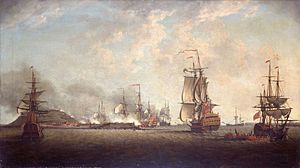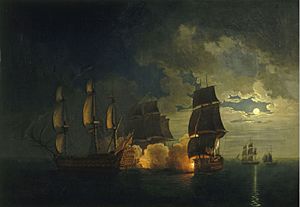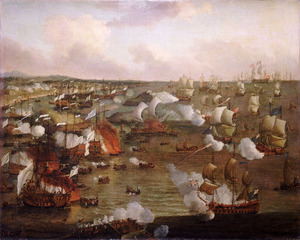HMS Neptune (1683) facts for kids

Attack on Gorée, 29 December 1758. Torbay is at the very centre of the picture bombarding the mole of the fort on her port side
|
|
Quick facts for kids History |
|
|---|---|
| Name | HMS Neptune |
| Ordered | 8 September 1678 |
| Builder | John Shish, Deptford Dockyard |
| Launched | 17 April 1683 |
| Renamed | HMS Torbay, 1750 |
| Fate | Sold, 1784 |
| General characteristics as built | |
| Class and type | 90-gun second-rate ship of the line |
| Tons burthen | 1,57646⁄94 (bm) |
| Length |
|
| Beam | 47 ft 3 in (14.4 m) |
| Depth of hold | 18 ft 10 in (5.7 m) |
| Sail plan | Full-rigged ship |
| Armament | 90 guns of various weights of shot |
| General characteristics after 1710 rebuild | |
| Class and type | 1706 Establishment 90-gun second-rate ship of the line |
| Tons burthen | 1,576 |
| Length | 163 ft 1.75 in (49.7 m) (gundeck) |
| Beam | 47 ft 3 in (14.4 m) |
| Depth of hold | 18 ft 6 in (5.6 m) |
| Propulsion | Sails |
| Sail plan | Full-rigged ship |
| Armament |
|
| General characteristics after 1730 rebuild | |
| Class and type | 1719 Establishment 90-gun second-rate ship of the line |
| Tons burthen | 1,572.5 |
| Length | 164 ft (50.0 m) (gundeck) |
| Beam | 47 ft 3 in (14.4 m) |
| Depth of hold | 18 ft 10 in (5.7 m) |
| Propulsion | Sails |
| Sail plan | Full-rigged ship |
| Armament |
|
HMS Neptune was a very large and powerful warship of the Royal Navy. She was a "second-rate" ship of the line, which meant she carried many guns and was important in naval battles. She was built in 1683 at Deptford Dockyard in England.
Contents
Early Years and First Rebuild
Neptune first entered service in 1690. She was the main ship for Vice-Admiral George Rooke. In May 1692, she took part in a big fight called the Battle of Barfleur.
After some years, Neptune was taken apart and rebuilt. This happened at William Johnson's yard in Blackwall Yard. She was relaunched in 1710, still as a 90-gun ship. However, she didn't see much action after this rebuild and was soon put into reserve.
Second Rebuild and Renaming
In 1724, Neptune was ordered to be rebuilt again. This time, the work was done at Woolwich Dockyard. She was relaunched in 1730.
Later, between 1747 and 1749, she was made smaller. Her number of guns was reduced to 74, making her a "third-rate" ship. On August 23, 1750, her name was changed to HMS Torbay.
Capturing a French Ship
On November 28, 1756, Torbay had an exciting encounter. She fought and defeated a French privateer ship called La Roche off the coast of Wales. A privateer was a private ship allowed to attack enemy ships during wartime.
Most of the French crew were taken prisoner on Torbay. Only two French sailors were left on La Roche with eight British sailors. Their job was to sail the captured French ship to an English port.
However, during the journey, the two French prisoners escaped! They attacked the British sailors, hurting some of them. The remaining British sailors had to surrender. The French tried to sail the ship back to France.
But the British sailors were clever. They made a hole in the ship's side and one sailor climbed out. He got back inside the ship on a different deck and found a musket. He shot one of the Frenchmen. The other Frenchman jumped overboard but was convinced to come back. The British sailors took control of La Roche again and sailed it to Milford Haven.

In 1759, under Captain Augustus Keppel, Torbay played a part in the Battle of Quiberon Bay. This was an important battle where the British navy defeated a French fleet.
End of Service
Torbay's last major battle was the Battle of the Saintes. This battle took place in 1782 in the Caribbean Sea.
After a long and active life, Torbay was sold in Portsmouth on August 17, 1784. She was then taken apart.


